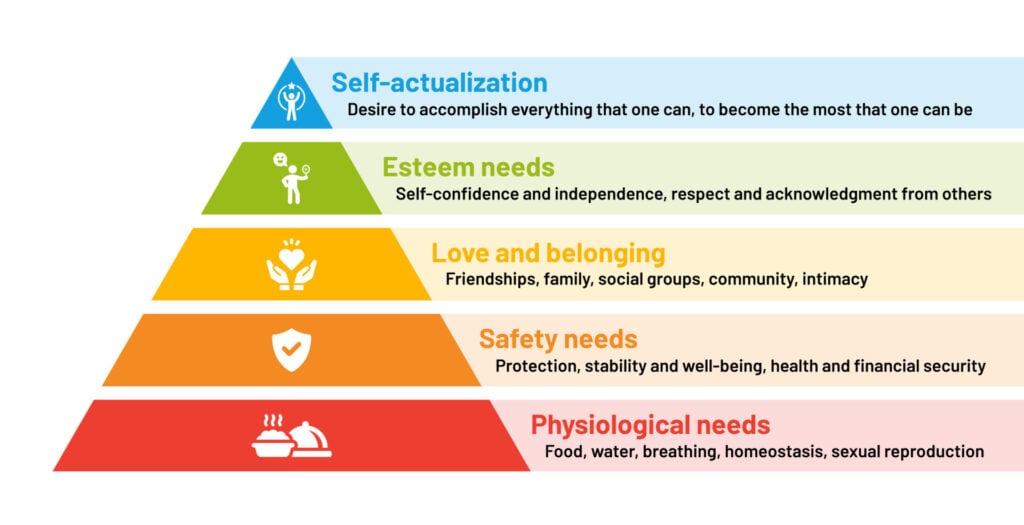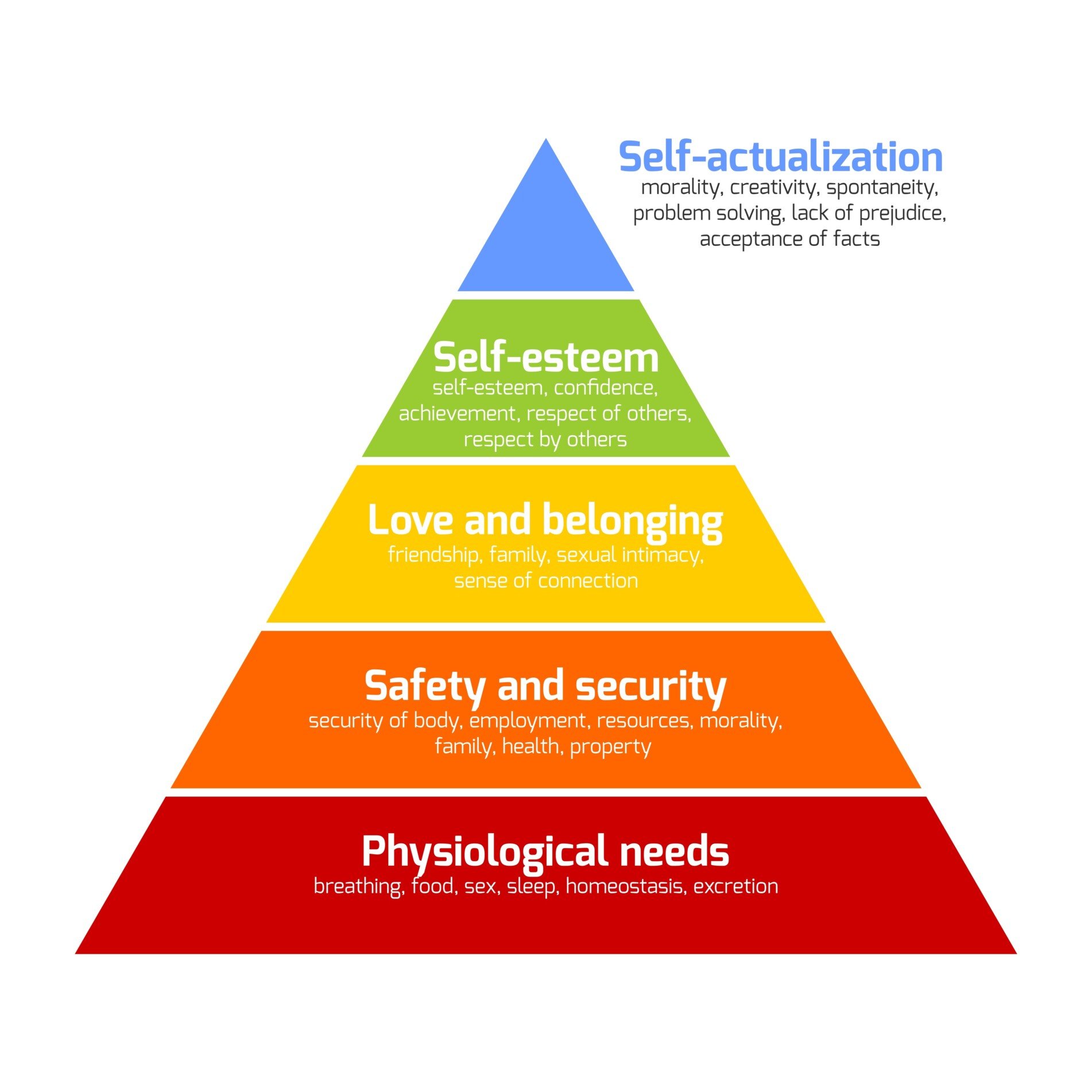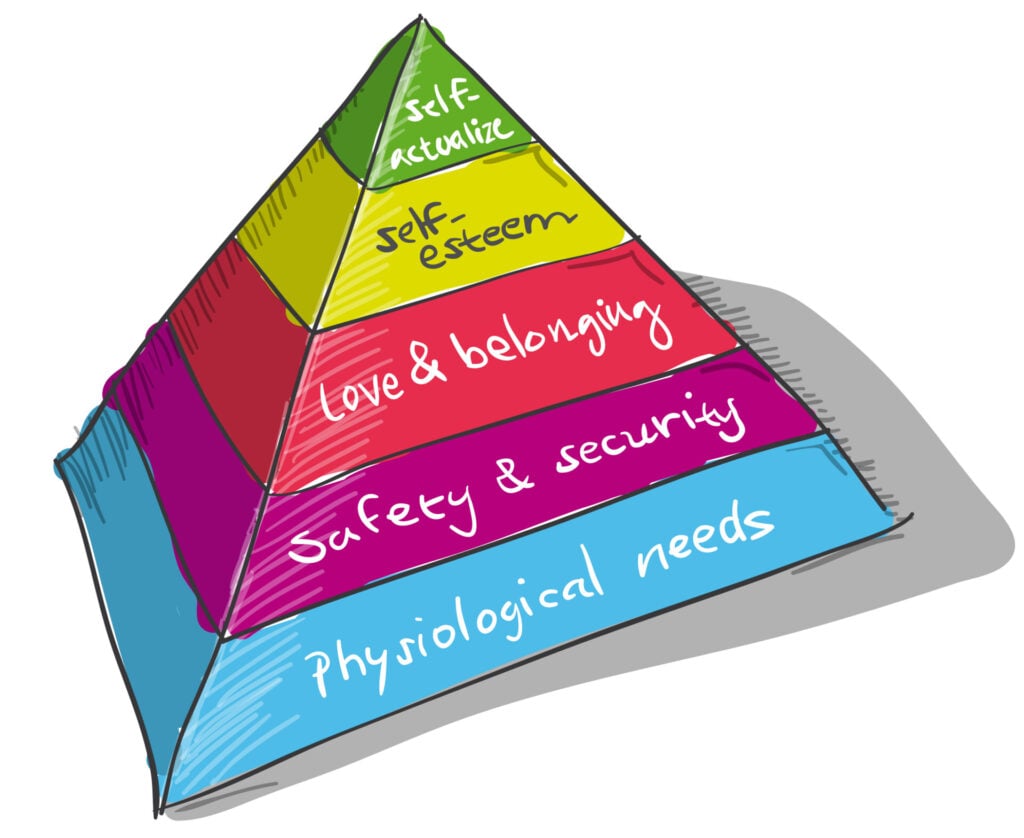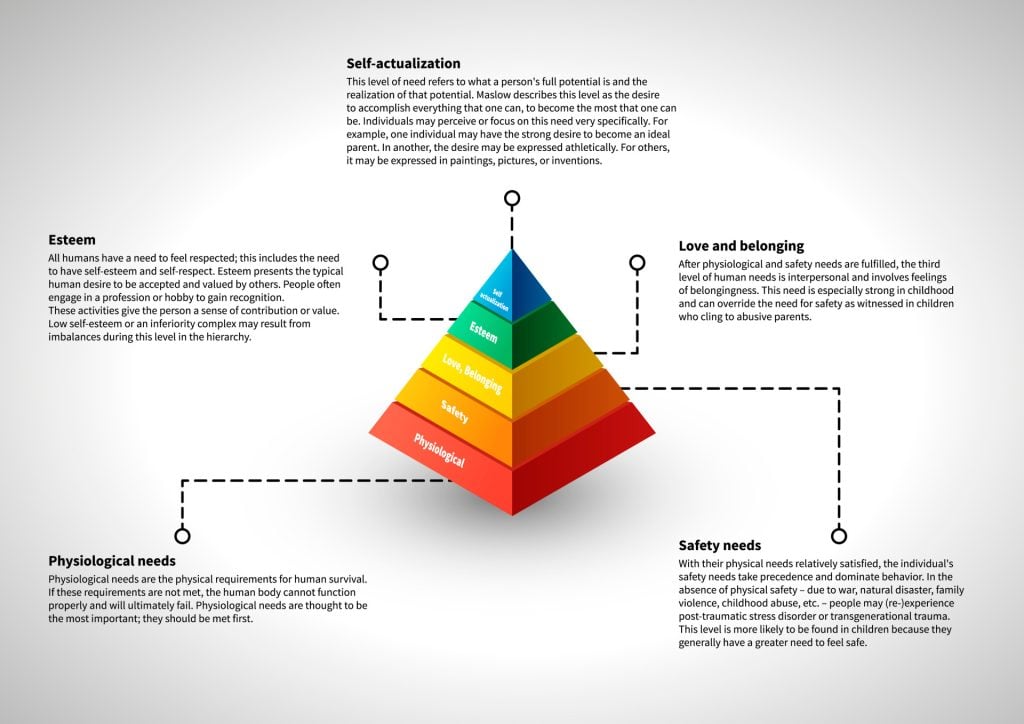Key Takeaways
- Maslow’s hierarchy of needs is a motivational theory in psychology comprising a five-tier model of human needs, often depicted as hierarchical levels within a pyramid.
- The five levels of the hierarchy are physiological, safety, love/belonging, esteem, and self-actualization.
- Lower-level basic needs like food, water, and safety must be met first before higher needs can be fulfilled.
- Few people are believed to reach the level of self-actualization, but we can all have moments of peak experiences.
- The order of the levels is not completely fixed. For some, esteem outweighs love, while others may self-actualize despite poverty. Our behaviors are usually motivated by multiple needs simultaneously.
- Applications include workplace motivation, education, counseling, and nursing.
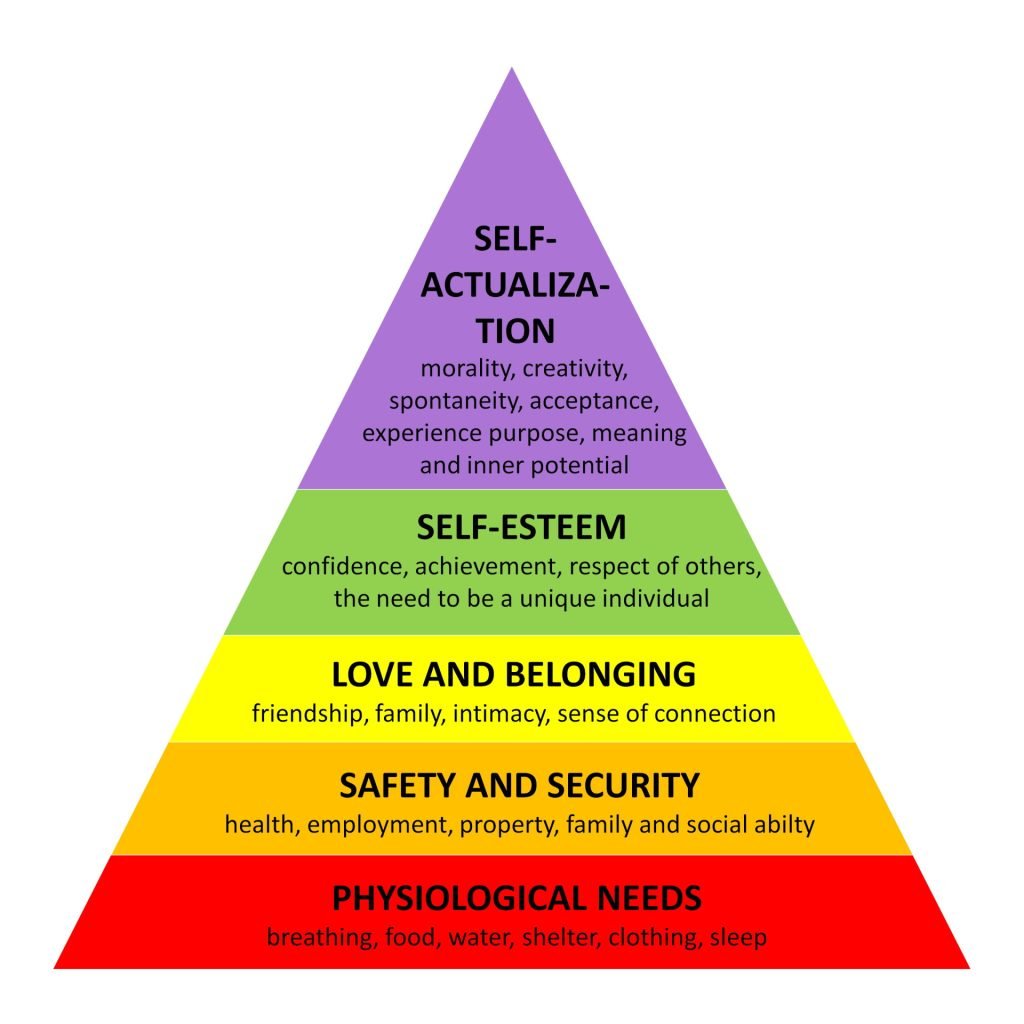
What is Maslow’s Hierarchy of Needs?
According to Maslow (1943, 1954), human needs were arranged in a hierarchy, with physiological (survival) needs at the bottom, and the more creative and intellectually oriented ‘self-actualization’ needs at the top.
Maslow argued that survival needs must be satisfied before the individual can satisfy the higher needs. The higher up the hierarchy, the more difficult it is to satisfy the needs associated with that stage, because of the interpersonal and environmental barriers that inevitably frustrate us.
Higher needs become increasingly psychological and long-term rather than physiological and short-term, as in the lower survival-related needs.
1. Physiological needs are biological requirements for human survival, e.g., air, food, drink, shelter, clothing, warmth, sex, and sleep.
Our most basic need is for physical survival, and this will be the first thing that motivates our behavior. Once that level is fulfilled, the next level up is what motivates us, and so on.
The human body cannot function optimally if physiological needs are not satisfied. Maslow considered physiological needs the most important as all the other needs become secondary until these needs are met.
Once an individual’s physiological needs are satisfied, the need for security and safety becomes salient.
2. Safety needs – people want to experience order, predictability, and control in their lives.
Safety needs can be fulfilled by the family and society (e.g., police, schools, business, and medical care).
For example, emotional security, financial security (e.g., employment, social welfare), law and order, freedom from fear, social stability, property, health, and well-being (e.g., safety against accidents and injury).
After physiological and safety needs have been fulfilled, the third level of human needs is social and involves feelings of belongingness.
3. Love and belongingness needs refers to a human emotional need for interpersonal relationships, affiliating, connectedness, and being part of a group.
Examples of belongingness needs include friendship, intimacy, trust, acceptance, receiving and giving affection, and love.
This need is especially strong in childhood and can override the need for safety, as witnessed in children who cling to abusive parents.
4. Esteem needs are the fourth level in Maslow’s hierarchy and include self-worth, accomplishment, and respect.
Maslow classified esteem needs into two categories: (i) esteem for oneself (dignity, achievement, mastery, independence) and (ii) the desire for reputation or respect from others (e.g., status, prestige).
Esteem is the typical human desire to be accepted and valued by others. People often engage in a profession or hobby to gain recognition, which gives them a sense of contribution or value.
Low self-esteem or an inferiority complex may result from imbalances during this level in the hierarchy.
Maslow indicated that the need for respect or reputation is most important for children and adolescents and precedes real self-esteem or dignity.
5. Self-actualization needs are the highest level in Maslow’s hierarchy, and refer to the realization of a person’s potential, self-fulfillment, seeking personal growth, and peak experiences.
This level of need refers to what a person’s full potential is and the realization of that potential.
Maslow (1943, 1987, p. 64) describes this level as the desire to accomplish everything that one can, and “to become everything one is capable of becoming”.
Individuals may perceive or focus on this need very specifically. For example, one individual may have a strong desire to become an ideal parent.
In another, the desire may be expressed athletically. For others, it may be expressed in paintings, pictures, or inventions.
Although Maslow did not believe that many of us could achieve true self-actualization, he did believe that all of us experience transitory moments (known as ‘peak experiences’) of self-actualization.
Such moments, associated with personally significant events such as childbirth, sporting achievement and examination success), are difficult to achieve and maintain consistently.
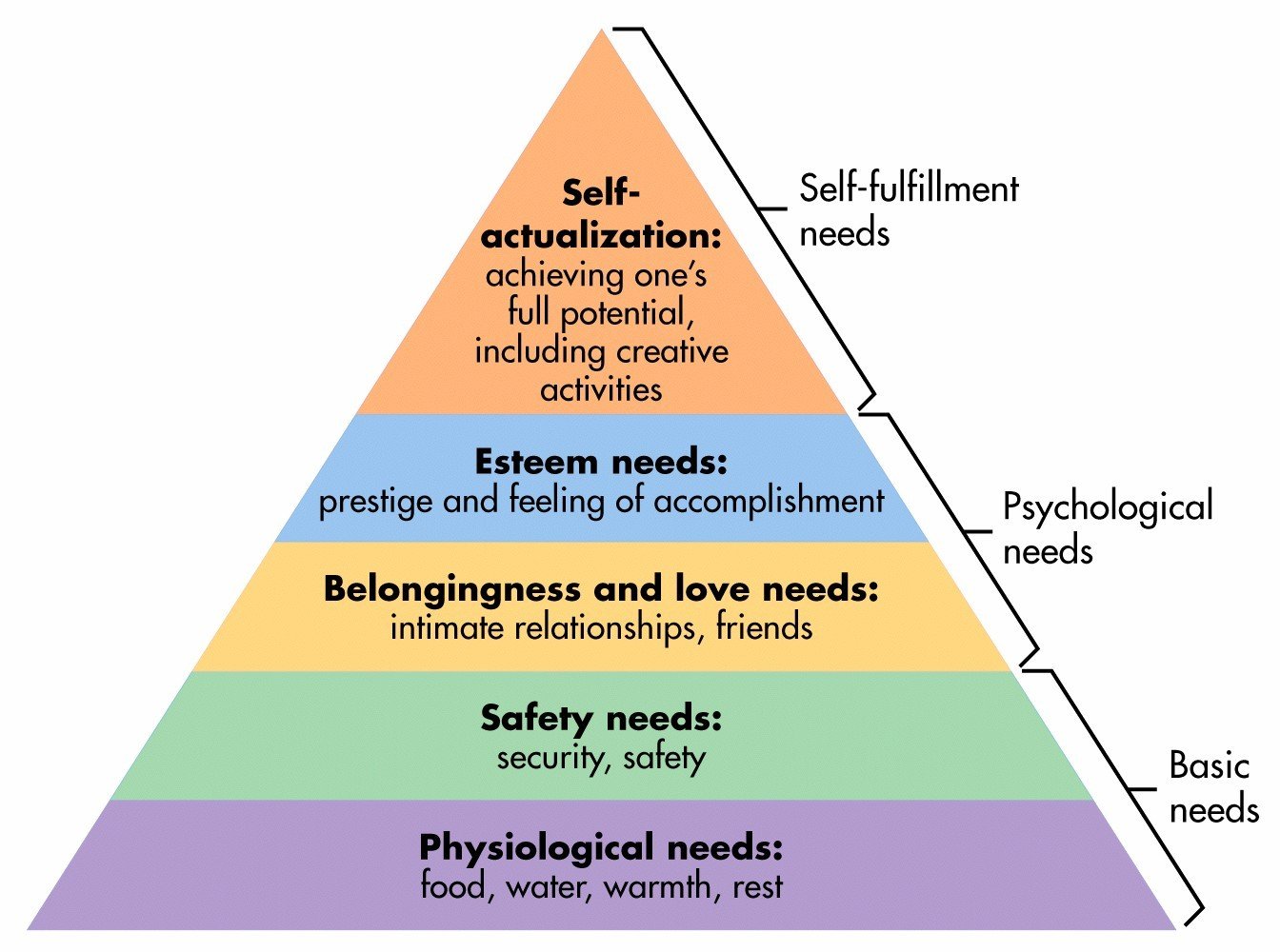
Maslow posited that human needs are arranged in a hierarchy:
“It is quite true that man lives by bread alone — when there is no bread. But what happens to man’s desires when there is plenty of bread and when his belly is chronically filled?
At once other (and “higher”) needs emerge and these, rather than physiological hungers, dominate the organism. And when these in turn are satisfied, again new (and still “higher”) needs emerge and so on. This is what we mean by saying that the basic human needs are organized into a hierarchy of relative prepotency” (Maslow, 1943, p. 375) .
Key Point: Keep in mind that Maslow’s hierarchy of needs doesn't follow a strict linear progression. Individuals can feel various needs at the same time or shift between levels.
Maslow continued to refine his theory based on the concept of a hierarchy of needs over several decades (Maslow, 1943, 1962, 1987).
Regarding the structure of his hierarchy, Maslow (1987) proposed that the order in the hierarchy “is not nearly as rigid” (p. 68) as he may have implied in his earlier description.
Maslow noted that the order of needs might be flexible based on external circumstances or individual differences. For example, he notes that for some individuals, the need for self-esteem is more important than the need for love. For others, the need for creative fulfillment may supersede even the most basic needs.
Maslow (1987) also pointed out that most behavior is multi-motivated and noted that “any behavior tends to be determined by several or all of the basic needs simultaneously rather than by only one of them” (p. 71).
Maslow (1954) proposed that human beings possess two sets of needs. This five-stage model can be divided into deficiency needs and growth needs. The first four levels are often referred to as deficiency needs (D-needs), and the top level is known as growth or being needs (B-needs).
Deficiency needs
Deficiency needs concern basic survival and include physiological needs (such as the need for food, sex, and sleep) and safety needs (such as the need for security and freedom from danger).
Behaviors associated with these needs are seen as ‘deficiency’ motivated, as they are a means to an end.
Deficiency needs arise due to deprivation and are said to motivate people when they are unmet. Also, the motivation to fulfill such needs will become stronger the longer they are denied. For example, the longer a person goes without food, the more hungry they will become.
Maslow (1943) initially stated that individuals must satisfy lower-level deficit needs before progressing to meet higher-level growth needs.
However, he later clarified that satisfaction of a need is not an “all-or-none” phenomenon, admitting that his earlier statements may have given “the false impression that a need must be satisfied 100 percent before the next need emerges” (1987, p. 69).
When a deficit need has been “more or less” satisfied, it will go away, and our activities become habitually directed toward meeting the next set of needs we have yet to satisfy. These then become our salient needs. However, growth needs continue to be felt and may even become stronger once engaged.
Growth needs
Growth needs are more psychological and are associated with realizing an individual’s full potential and needing to ‘self-actualize’. These needs are achieved more through intellectual and creative behaviors.
Growth needs do not stem from a lack of something but rather from a desire to grow as a person. Once these growth needs have been reasonably satisfied, one may be able to reach the highest level, called self-actualization. Growth needs are achieved more through intellectual and creative behaviors.
Every person is capable and has the desire to move up the hierarchy toward a level of self-actualization. Unfortunately, progress is often disrupted by a failure to meet lower-level needs.
Life experiences, including divorce and the loss of a job, may cause an individual to fluctuate between levels of the hierarchy.
Therefore, not everyone will move through the hierarchy in a uni-directional manner but may move back and forth between the different types of needs.
The expanded hierarchy of needs
It is important to note that Maslow’s (1943, 1954) five-stage model has been expanded to include cognitive and aesthetic needs (Maslow, 1970a) and later transcendence needs (Maslow, 1970b).

Changes to the original five-stage model are highlighted and include a seven-stage model and an eight-stage model; both developed during the 1960s and 1970s.
- Biological and physiological needs – air, food, drink, shelter, warmth, sex, sleep, etc.
- Safety needs – protection from elements, security, order, law, stability, freedom from fear.
- Love and belongingness needs – friendship, intimacy, trust, and acceptance, receiving and giving affection and love. Affiliating, being part of a group (family, friends, work).
- Esteem needs – which Maslow classified into two categories: (i) esteem for oneself (dignity, achievement, mastery, independence) and (ii) the need to be accepted and valued by others (e.g., status, prestige).
-
Cognitive needs – knowledge and understanding, curiosity, exploration, need for meaning and predictability.
Cognitive needs drive our pursuit of knowledge and understanding. For instance, a student’s desire to understand complex mathematical theories, a traveler’s curiosity about diverse cultures, or an individual’s quest for life’s deeper meanings all exemplify these needs.
Meeting these needs facilitates personal growth, comprehension, and a deeper understanding of life and its complexities.
-
Aesthetic needs – appreciation and search for beauty, balance, form, etc. Fulfilling these needs leads to a deeper sense of satisfaction and harmony in life, as individuals seek environments and experiences that are pleasing and resonant with their sense of beauty.
This involves the appreciation and pursuit of art, music, nature, and other forms of aesthetic expression.
Fulfilling these needs isn’t just about physical beauty but also the emotional and psychological satisfaction derived from experiencing order and elegance.
- Self-actualization needs – realizing personal potential, self-fulfillment, seeking personal growth, and peak experiences.
-
Transcendence needs – A person is motivated by values that transcend beyond the personal self. Beyond self-actualization, they represent the human desire to connect with a higher reality, purpose, or the universe.
This level emphasizes altruism, spiritual connection, and helping others achieve their potential.
Individuals seek experiences that move beyond personal concerns, aiming to achieve a deep sense of unity, understanding, and belonging within the vast expanse of existence.
Examples of transcendence needs include mystical experiences and certain experiences with nature, aesthetic experiences, sexual experiences, service to others, the pursuit of science, religious faith, etc.).
Self-Actualization Needs
Instead of focusing on psychopathology and what goes wrong with people, Maslow (1943) formulated a more positive account of human behavior which focused on what goes right. He was interested in human potential, and how we fulfill that potential.
Psychologist Abraham Maslow (1943, 1954) stated that human motivation is based on people seeking fulfillment and change through personal growth. Self-actualized people are those who are fulfilled and doing all they are capable of.
The growth of self-actualization (Maslow, 1962) refers to the need for personal growth and discovery that is present throughout a person’s life. For Maslow, a person is always “becoming” and never remains static in these terms. In self-actualization, a person comes to find a meaning in life that is important to them.
As each individual is unique, the motivation for self-actualization leads people in different directions (Kenrick et al., 2010). For some people, self-actualization can be achieved through creating works of art or literature; for others, through sports, in the classroom, or within a corporate setting.
Maslow (1962) believed self-actualization could be measured through the concept of peak experiences. This occurs when a person experiences the world totally for what it is, and there are feelings of euphoria, joy, and wonder.
It is important to note that self-actualization is a continual process of becoming rather than a perfect state one reaches of a “happy ever after” (Hoffman, 1988).
Maslow offers the following description of self-actualization:
“It refers to the person’s desire for self-fulfillment, namely, to the tendency for him to become actualized in what he is potentially.
The specific form that these needs will take will of course vary greatly from person to person. In one individual it may take the form of the desire to be an ideal mother, in another it may be expressed athletically, and in still another it may be expressed in painting pictures or in inventions” (Maslow, 1943, p. 382–383).
Characteristics of Self-Actualized People
Although we are all, theoretically, capable of self-actualizing, most of us will not do so, or only to a limited degree. Maslow (1970) estimated that only two percent of people would reach the state of self-actualization.
He was especially interested in the characteristics of people whom he considered to have achieved their potential as individuals.
By studying 18 people, he considered to be self-actualized (including Abraham Lincoln and Albert Einstein), Maslow (1970) identified 15 characteristics of a self-actualized person.
Characteristics of self-actualizers:
- They perceive reality efficiently and can tolerate uncertainty;
- Accept themselves and others for what they are;
- Spontaneous in thought and action;
- Problem-centered (not self-centered);
- Unusual sense of humor;
- Able to look at life objectively;
- Highly creative;
- Resistant to enculturation, but not purposely unconventional;
- Concerned for the welfare of humanity;
- Capable of deep appreciation of basic life-experience;
- Establish deep satisfying interpersonal relationships with a few people;
- Peak experiences;
- Need for privacy;
- Democratic attitudes;
- Strong moral/ethical standards.
Behavior leading to self-actualization:
- Experiencing life like a child, with full absorption and concentration;
- Trying new things instead of sticking to safe paths;
- Listening to your own feelings in evaluating experiences instead of the voice of tradition, authority or the majority;
- Avoiding pretense (“game playing”) and being honest;
- Being prepared to be unpopular if your views do not coincide with those of the majority;
- Taking responsibility and working hard;
- Trying to identify your defenses and having the courage to give them up.
The characteristics of self-actualizers and the behaviors leading to self-actualization are shown in the list above.
Although people achieve self-actualization in their own unique way, they tend to share certain characteristics. However, self-actualization is a matter of degree, ‘There are no perfect human beings’ (Maslow, 1970a, p. 176).
It is not necessary to display all 15 characteristics to become self-actualized, and not only self-actualized people will display them.
Maslow did not equate self-actualization with perfection. Self-actualization merely involves achieving one’s potential. Thus, someone can be silly, wasteful, vain and impolite, and still self-actualize. Less than two percent of the population achieve self-actualization.
Applications & Examples
Workplace organizations and employee motivation
The theory applies to organizational structures and the motivation of employees. To enhance performance, the organizational culture and HR strategies must address and fulfill the needs of employees.
HR strategies, including compensation, benefits, job design, training, cultural development, and performance evaluations, can be tailored to cater to Maslow’s hierarchy of needs (Jerome, 2013).
1. What can managers do to motivate employees with physiological needs?
At the foundational physiological level, organizations should provide wages that sustain a decent standard of living and comprehensive benefits, ensuring employees can comfortably cater to necessities such as food, shelter, and medical care.
- Offer comprehensive healthcare benefits – Quality health insurance, dental, vision, mental health coverage, and wellness programs demonstrate you care about employees’ overall health and ability to afford care.
- Subsidize gym memberships – Some companies offer monthly gym subsidies or onsite fitness centers to support physical health and stress management.
- Make the space ergonomic – Ensure workstations, chairs, keyboards, etc. are height adjustable and comfortable to work at for extended periods to prevent bodily strain or injury.
- Pay for wellness services – Some companies offer perks like free annual flu shots, smoking cessation programs, or biometric screenings to proactively address health.
2. What can managers do to motivate employees with safety needs?
For the safety tier, offering job stability, secure working conditions, and equitable compensation is essential. Employees are more motivated when they feel both financially stable and physically safe within their workplace.
- Establish anti-harassment policies and reporting procedures – Ensure strong systems are in place for reporting issues confidentially and without retaliation.
- Cultivate psychological safety – Foster an environment where people feel safe to take risks, make mistakes, and speak up without fear of embarrassment or punishment.
- Define and reinforce ethical standards – Clearly establish and model expected conduct to prevent ethical lapses that undermine security.
- Promote transparency in pay and promotion practices – Clearly communicate compensation structure, advancement criteria, and salary negotiation options to build trust.
3. What can managers do to motivate employees with social needs?
Addressing social needs involves cultivating an inclusive community within the organization. Team-building exercises, social gatherings, mentorship initiatives, and transparent communication can foster a sense of belonging. Motivation is heightened when employees feel appreciated and integrated within their teams.
- Develop mother’s rooms – Providing clean, private lactation rooms supports new mothers’ needs to pump breast milk during work hours.
- Train supervisors in mental health first aid – Equip leaders to recognize signs of depression, anxiety, substance abuse and properly intervene or connect employees with help.
- Develop a mentorship program – Allow experienced employees to mentor newer ones to establish interpersonal bonds and a sense of support.
- Model inclusive language and behavior – Use words and actions that are welcoming and respectful to all groups.
- Share vulnerability and imperfections – Leaders should open up on mistakes, challenges, and lessons learned to humanize the workplace.
4. What can managers do to motivate employees with esteem needs?
To cater to esteem needs, organizations should implement recognition systems, merit-based promotions, and leadership roles.
- Leverage unique talents – Properly designated titles that reflect an individual’s role and status can also be beneficial.
- Make the most of performance reviews – Regular performance evaluations not only offer recognition but also highlight areas for growth, feeding into the employees’ need for esteem. Thoroughly highlight strengths, progress made, and areas of influence.
- Entrust employees with mentoring roles – Having them share knowledge and coach others recognizes their expertise.
What can managers do to motivate employees with self-actualization needs?
For self-actualization, organizations should ensure that job roles align with employees’ talents and passions. By empowering employees, presenting them with challenges, and fostering an environment that encourages innovation, organizations can facilitate their journey toward self-actualization.
- Foster innovation – Dedicate time and resources for experimenting with new ideas without pressure.
- Sponsor continuing education – Provide tuition reimbursement or subsidies for advanced courses and certificate programs. Offer paid time for relevant reading, online courses, conferences, and seminars.
Nursing
The hierarchy provides a framework for understanding patients as multifaceted human beings.
Patient care should be holistic, not just medical. Nurses must assess and address the spectrum of patient needs – physical, mental, emotional, and social (Jackson et al., 2014; Toney-Butler & Thayer, 2023).
Doing so motivates greater engagement in care, faster healing, and improved outcomes.
- Physiological needs (ABC + D) – Ensure patients have adequate nutrition, hydration, pain control, sleep, and physical comfort. Address pain that hinders sleep and recovery.
- A – Airway: Ensure the patient has an open airway.
- B – Breathing: Assess and support adequate breathing and gas exchange.
- C – Circulation: Evaluate and maintain proper blood circulation.
- D – Decreased level of consciousness: Monitor for any changes in behavior or mental status.
- Safety needs – Maintain a clean, quiet environment with call bells for assistance. Prevent injuries through fall precautions, blood clot prevention, and pressure ulcer avoidance.
Explain tests, treatments, and medications to patients to relieve anxiety. Keep patient info confidential. Foster a climate of trust through compassionate listening. Prevent medication errors.
- Belongingness – Loneliness impedes healing. Make patients feel welcomed and included. Introduce them to other patients. Allow for family visitation and spiritual practices.
- Esteem – Show respect through courteous communication and cultural sensitivity. Maintain dignity and privacy.
Empower patients in care decisions. Explain care in an easy-to-understand way. Listen attentively to their concerns. Make them feel valued.
- Self-actualization— Align care with patient values and aspirations. Perhaps share motivational stories of those with similar diagnoses who stayed active or provide resources on coping with grief over health changes.
Special Considerations
- Pain Management: While pain is typically considered a physiological need, its priority can vary. Acute, severe pain or pain indicating a life-threatening condition should be addressed immediately.
- Hospice Care: For end-of-life care patients, comfort and quality of life may take precedence over addressing physiological needs.
Education
Maslow’s (1962) hierarchy of needs theory has made a major contribution to teaching and classroom management in schools. Rather than reducing behavior to a response in the environment, Maslow (1970a) adopts a holistic approach to education and learning.
Maslow examines an individual’s complete physical, emotional, social, and intellectual qualities and how they impact learning.
Applying Maslow’s hierarchy theory to the work of the classroom teacher is obvious. Before a student’s cognitive needs can be met, they must first fulfill their basic physiological needs.
For example, a tired and hungry student will find it difficult to focus on learning. Students need to feel emotionally and physically safe and accepted within the classroom to progress and reach their full potential.
Maslow suggests students must be shown that they are valued and respected in the classroom, and the teacher should create a supportive environment. Students with a low self-esteem will not progress academically at an optimum rate until their self-esteem is strengthened.
Maslow’s hierarchy provides a humanistic lens for teaching the whole child.
Maslow (1971, p. 195) argued that a humanistic educational approach would develop people who are “stronger, healthier, and would take their own lives into their hands to a greater extent. With increased personal responsibility for one’s personal life, and with a rational set of values to guide one’s choosing, people would begin to actively change the society in which they lived”.
Here are some ways a teacher can apply Maslow’s hierarchy of needs in the classroom:
- Physiological – Ensure students have access to water, food, restroom breaks, and movement. Allow snacks, flexible seating, and adequate breaks.
- Safety – Maintain an orderly classroom with clear expectations. Prevent bullying. Build trust through consistency and fairness. Allow students to make mistakes safely.
- Belongingness – Facilitate community and collaboration. Foster teamwork through group projects. Learn student names and backgrounds. Appreciate diversity.
- Esteem – Recognize student strengths and progress. Display student work. Empower leadership roles like line leader or tech helper. Praise efforts, not just achievement.
- Self-Actualization – Help students pursue interests creatively. Assign passion projects. Encourage goal-setting. Provide enrichment opportunities. Support challenging oneself.
When these foundational needs are met, students are more motivated to learn and perform well academically. But needs fluctuate. Be observant and nurture needs as they arise.
Critical Evaluation
The most significant limitation of Maslow’s theory concerns his methodology. Maslow formulated the characteristics of self-actualized individuals by undertaking a qualitative method called biographical analysis.
He looked at the biographies and writings of 18 people he identified as being self-actualized. From these sources, he developed a list of qualities that seemed characteristic of this specific group of people, as opposed to humanity in general.
From a scientific perspective, there are numerous problems with this particular approach. First, it could be argued that biographical analysis as a method is extremely subjective as it is based entirely on the opinion of the researcher.
Personal opinion is always prone to bias, which reduces the validity of any data obtained. Therefore Maslow’s operational definition of self-actualization must not be blindly accepted as scientific fact.
Furthermore, Maslow’s biographical analysis focused on a biased sample of self-actualized individuals, prominently limited to highly educated white males (such as Thomas Jefferson, Abraham Lincoln, Albert Einstein, William James, Aldous Huxley, and Beethoven).
Although Maslow (1970) did study self-actualized females, such as Eleanor Roosevelt and Mother Teresa, they comprised a small proportion of his sample.
This makes it difficult to generalize his theory to females and individuals from lower social classes or different ethnicity. Thus questioning the population validity of Maslow’s findings.
Furthermore, it is extremely difficult to empirically test Maslow’s concept of self-actualization in a way that causal relationships can be established.
It is difficult to tell in Maslow’s theory where the scientific leaves off and the inspiration begins. His theory is seen as more speculative than empirically proven, with a tendency to substitute rhetoric for research.
Another criticism concerns Maslow’s assumption that the lower needs must be satisfied before a person can achieve their potential and self-actualize. This is not always the case, and therefore, Maslow’s hierarchy of needs in some aspects has been falsified.
Through examining cultures in which large numbers of people live in poverty (such as India), it is clear that people are still capable of higher-order needs such as love and belongingness.
However, this should not occur, as according to Maslow, people who have difficulty achieving very basic physiological needs (such as food, shelter, etc.) are not capable of meeting higher growth needs.
Also, many creative people, such as authors and artists (e.g., Rembrandt and Van Gogh) lived in poverty throughout their lifetime, yet it could be argued that they achieved self-actualization.
Psychologists now conceptualize motivation as a pluralistic behavior, whereby needs can operate on many levels simultaneously. A person may be motivated by higher growth needs at the same time as lower-level deficiency needs (Wahba & Bridwell, 1973).
Contemporary research by Tay and Diener (2011) has tested Maslow’s theory by analyzing the data of 60,865 participants from 123 countries, representing every major region of the world. The survey was conducted from 2005 to 2010.
Respondents answered questions about six needs that closely resemble those in Maslow’s model: basic needs (food, shelter); safety; social needs (love, support); respect; mastery; and autonomy.
They also rated their well-being across three discrete measures: life evaluation (a person’s view of his or her life as a whole), positive feelings (day-to-day instances of joy or pleasure), and negative feelings (everyday experiences of sorrow, anger, or stress).
The results of the study support the view that universal human needs appear to exist regardless of cultural differences. However, the ordering of the needs within the hierarchy was not correct.
“Although the most basic needs might get the most attention when you don”t have them,” Diener explains, “you don”t need to fulfill them in order to get benefits [from the others].”
Even when we are hungry, for instance, we can be happy with our friends. “They”re like vitamins,” Diener says about how the needs work independently. “We need them all.”
Conclusion
Maslow’s theory differs from more purely physiological representations of human motivation because motivation is seen as being not just concerned with tension reduction and survival but also with human growth and development.
While Maslow’s work was indeed relatively informal and clinically descriptive, it did provide a rich source of ideas, and as such, a framework for discussing the richness and complexity of human motivation that goes beyond homeostatic models and other biological models.
Frequently Asked Questions
What are some of the weaknesses of Maslow’s theory?
Maslow proposes a positive view of humans, however, it could be argued that this might not be very realistic when considering everyday reality such as domestic violence and genocides.
Furthermore, the hierarchy’s focus on meeting our needs and fulfilling our growth potential reflects an individualistic, self-obsessed outlook that is part of the problem faced by our society rather than a solution.
How many levels are there in Maslow’s pyramid of needs?
There are five levels in Maslow’s pyramid. From the bottom of the hierarchy upwards, the needs are: physiological (food and clothing), safety (job security), love and belonging needs (friendship), esteem, and self-actualization.
Maslow asserted that so long as basic needs necessary for survival were met (e.g., food, water, shelter), higher-level needs (e.g., social needs) would begin to motivate behavior.
Why is Maslow’s hierarchy of needs important?
Maslow’s theory has given rise to a new way to look at people’s needs. For example, Maslow’s hierarchy of needs is widely used in health and social work as a framework for assessing clients’ needs.
Problems or difficult circumstances at one point in a person’s life can cause them to fixate on a particular set of needs, and this can affect their future happiness.
For example, a person who lived through a period of extreme deprivation and lack of security in early childhood may fixate on physiological and safety needs. These remain salient even if they are satisfied.
So even if this person later has everything they need they may nonetheless obsess over money or keeping enough food in the fridge.
This, for Maslow, was the root cause of many ‘neurotic’ mental health problems, such as anxiety or depression.
What is at the top of Maslow’s hierarchy of needs?
According to Maslow, the highest-level needs relate to self-actualization, a process by which we achieve our full potential.
Self-actualizing people have both a more efficient perception of reality and more comfortable relations with it. This includes the detection of what is phony and/or dishonest and the accurate perception of what really exists – rather than a distortion of perception by one’s needs.
Self-actualizers accept themselves, others and nature. They are not ashamed or guilty about being human, with shortcomings, imperfections, frailties, and weaknesses.
Nor are they critical of these aspects in other people. They respect and esteem themselves and others.
References
Geller, L. (1982). The failure of self-actualization theory: A critique of Carl Rogers and Abraham
Maslow. Journal of Humanistic Psychology, 22, 56–73.
Hoffman, E. (1988). The right to be human: A biography of Abraham Maslow. Los Angeles, CA: Jeremy P. Tarcher.
Ivtzan, I. (2008). Self actualisation: For individualistic cultures only? International Journal on
Humanistic Ideology, 1, 113–140.
Jackson, J. C., Santoro, M. J., Ely, T. M., Boehm, L., Kiehl, A. L., Anderson, L. S., & Ely, E. W. (2014). Improving patient care through the prism of psychology: Application of Maslow’s hierarchy to sedation, delirium, and early mobility in the intensive care unit. Journal of Critical Care, 29(3), 438-444.
Jerome, N. (2013). Application of the Maslow’s hierarchy of need theory; impacts and implications on organizational culture, human resource and employee’s performance. International Journal of Business and Management Invention, 2(3), 39-45.
Kenrick, D. T., Neuberg, S. L., Griskevicius, V., Becker, D. V., & Schaller, M. (2010). Goal-driven cognition and functional behavior: The fundamental-motives framework. Current Directions in Psychological Science, 19 (1), 63-67.
King-Hill, S. (2015). Critical analysis of Maslow’s hierarchy of need. The STeP Journal (Student Teacher Perspectives), 2(4), 54-57.
Maslow, A. H. (1943). A theory of human motivation. Psychological Review, 50 (4), 370-96.
Maslow, A. H. (1954). Motivation and personality. New York: Harper and Row.
Maslow, A. H. (1962). Toward a psychology of being. Princeton: D. Van Nostrand Company.
Maslow, A. H. (1970a). Motivation and personality. New York: Harper & Row.
Maslow, A. H. (1970b). Religions, values, and peak experiences. New York: Penguin. (Original work published 1966)
Maslow, A. H. (1987). Motivation and personality (3rd ed.). Delhi, India: Pearson Education.
Mittelman, W. (1991). Maslow’s study of self-actualization: A reinterpretation. Journal of Humanistic Psychology, 31(1), 114-135.
Neher, A. (1991). Maslow’s theory of motivation: A critique. Journal of Humanistic Psychology,
31, 89–112.
Tay, L., & Diener, E. (2011). Needs and subjective well-being around the world. Journal of Personality and Social Psychology, 101 (2), 354-356.
Toney-Butler, T.J., & Thayer, J.M. (2023, April 10). Nursing Process. In StatPearls. StatPearls Publishing. https://www.ncbi.nlm.nih.gov/books/NBK499937/
Wahba, M. A., & Bridwell, L. G. (1976). Maslow reconsidered: A review of research on the need hierarchy theory. Organizational Behavior and Human Performance, 15 (2), 212-240.
Wulff, D. M., & Maslow, A. H. (1965). Religions, values, and peak-experiences. The Journal of Higher Education, 36 (4), 235.
Further Information
- Maslow’s Theories
- Maslow Hierarchy of Needs Infographic Poster
- Hierarchy of Needs
- Maslow Reconsidered: A Review of Research on the Need Hierarchy Theor
- BBC Radio 4 Programme: Maslow and the Hierarchy of Needs
- Questionnaire: Are you self-actualized? How to Write a Psychology Essay
Hierarchy of Needs and Nursing
- A Nursing Diagnosis Using Maslow’s Hierarchy of Needs
- Improving Patient Care Through the Prism of Psychology: application of Maslow’s Hierarchy to Sedation, Delirium and Early Mobility in the ICU
- Maslow’s Hierarchy of Needs Adapted for Nursing (Image)
Hierarchy of Needs in the Workplace
- Organizational Culture, Human Resource and Employee’s Performance
- Improving Workplace Productivity: Applications of Maslow’s Need Theory and Locke’s Goal-Setting
Images

